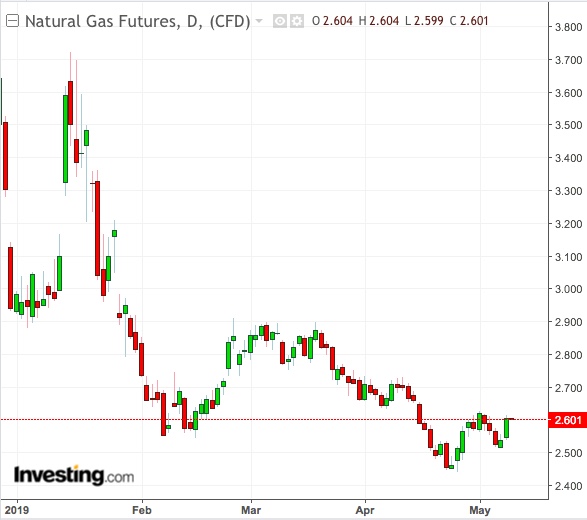U.S. natural gas production is hitting record highs week after week. But bets for a spike in summer heating and LNG (liquified natural gas) demand is preventing prices of the fuel from caving, throwing market bulls a lifeline.
Underground storage caverns have been filling with gas as mild weather that requires neither heating nor cooling prompts utilities to inject the bulk of what they produce each week, after using a portion for electricity generation.
While the U.S. Energy Information Administration is expected to cite a smaller storage build of 85 billion cubic feet for last week in its supply-demand report due at 10:30 AM ET (14:30 GMT) today—versus the previous weekly injection of 123 bcf—the tapering could be a one-off event.
Dan Myers, analyst at Gelber & Associates, believes storage injections will be back to triple digits in the coming weeks.
With weather-related demand virtually non-existent in key gas consuming areas like the U.S. Northeast, bulls are betting big on summer air-conditioning instead. And stronger prices farther out are transitioning into some near-term support.
High Gas Consumption Expected When Summer Heat Kicks In
Said Gelber’s Myers in a note issued Wednesday:
“Despite the impressive start to injection season, Gelber still expects storage stocks to have difficulty catching up with 5-year average levels by the end of the season.”
“Favorable prices and relatively low volatility will encourage high rates of natural gas power generation once summer heat creeps in.”
Myers said growing exports of LNG could also cut into injection rates.
He added:
“Additionally, although the current state of oversupply is likely to continue weighing on the market for most of this year, we expect slower production growth and the final round of LNG completions to lead to stronger spot prices in 2020, just under $3/mmBtu.”
In Wednesday’s session, the spot June contract for natural gas on New York Mercantile Exchange’s Henry Hub settled up 7 cents, or nearly 3%, at $2.610 per million metric British thermal units. The rally was in anticipation of the smaller weekly storage build forecast for today from the EIA.
'Strong Buy' Recommended Despite Disputable Weather Demand
Investing.com daily technical outlook has a “Strong Buy” on Henry Hub’s June gas, projecting a major resistance of $2.711—or nearly 4% higher from Wednesday’s settlement.
Dominick Chirichella, director of risk and trading at the Energy Management Institute in New York, attributes some of the futures market’s immediate strength to short-covering on recent price declines.
While near-term weather demand was disputable, Chirichella said anomalies like a cooler-than-normal U.S. Southwest and Plains were keeping Henry Hub spot contract supported.

Traders have been at their wits' end on how to price natural gas in recent weeks, with the market trapped in the “shoulder season” between late spring and peak summer demand, which doesn't kick in until mid-June at least.
Last week’s weather was warmer than normal, with 58 heating degree days (HDDs), said Reuters, which noted the 30-year normal for the period at 49 HDDs. In the same week last year, there were 40 HDDs.
HDDs measure the number of degrees a day's average temperature is below 65 Fahrenheit (18 Celsius) and are used to estimate demand to heat homes and businesses.
LNG Key To Market’s Future After 2019 Spike
Scott Shelton, energy futures broker at ICAP in Durham, North Carolina, said he was maintaining his bullish gas bias based on the LNG exports situation.
U.S. LNG shipments to Europe, particularly, have soared this year, rising more than 200%, after European Commission President Jean-Claude Juncker assured U.S. President Donald Trump that the EU would buy more of the fuel from America.
The European Union has promised to double its intake of U.S. liquefied natural gas over the next five years, with the annual total reaching the equivalent of 8 billion cubic meters in 2023, double the current annual rate of imports.
But even with that LNG ramp-up, Shelton conceded that “overall, with a lack of weather demand, the market information is about as mixed as the price action is”.
